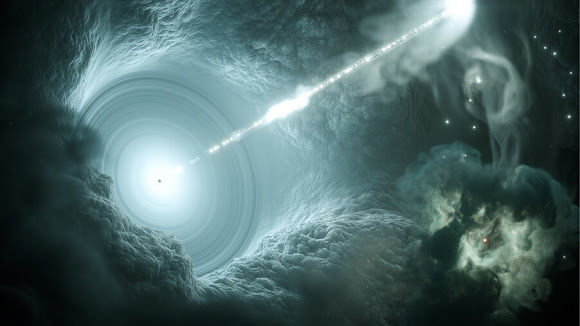There are objects in the Universe of which I am in awe. And there are observations of them that also engender those same feelings.
OJ 287 is one of them. It's a rare type of galaxy called a blazar, where the very center of the galaxy is blasting out light across the electromagnetic spectrum, including super-high-energy gamma rays, in prodigious quantities. Just in that tiny central region it glows with the light of a trillion Suns, outshining the rest of the galaxy combined. Happily, it's 3.5 billion light years away. It's best to keep a decent chunk of the Universe between you and a monster like this.
The engine behind this soul-vaporizing energy is a black hole that will stomp your brain: It has a mass of over 18 billion times that of the Sun, making it one of the most massive known, and perhaps one of the most massive possible. A vast disk of material called an accretion disk swirls around it, gas and dust heated to unbelievable temperatures, that heat creating the energies we see from the galaxy.
There's more, incredibly: Another supermassive black hole is in tight orbit around the central monster, and it too is a beast, 150 million solar masses. Its elliptical path takes it within 500 billion kilometers of the bigger black hole, which is a long way — over 100 times the distance from the Sun to Neptune — but the disk of material is so huge it stretches much further. So twice per orbit the second black hole plunges directly through this disk like a rocket piercing a cloud. And when it does, some as-yet not fully understood mechanism creates an immense additional blast of radiation.
Who of us with any imagination at all would not be in awe of such forces?
OJ287 was discovered well over a hundred years ago and has been studied assiduously ever since. But new observations made by a team of astronomers have revealed more details about the inner working of the galaxy than ever before, and as interesting as the science is, the observations themselves are phenomenal (link to paper).
The observations were made at radio wavelengths using a process called interferometry. It uses a complex process to be able to simultaneously combine the abilities of radio telescopes across the world, in essence creating a single linked telescope with the same resolution — the ability to distinguish details in an object — as one the size of the distance between them. I've written about this many times, including imaging the first ever "shadow" of a black hole, a red giant star's surface, and exoplanets around other stars.
This technique can link up radio telescopes around the world, making an Earth-sized telescope. But the new observations of OJ287 take it a step farther: They added in the Spektr-R 10-meter radio telescope that's in orbit around the Earth. The orbit is elliptical, taking it down close to our planet and nearly as far out as the Moon. The observations of OJ287 increased the baseline between telescopes from the size of the Earth to one 15 times larger. The astronomers report that some their observations have a resolution of 12 microarcseconds, which is so small it's difficult to grasp. It's like being able to see a US quarter from halfway to the Moon.
Hubble has a resolution of very roughly 0.05 arcseconds. These observations are roughly 40,000 times sharper. Yegads. Even their lower resolution images have a resolution of 50 microarcseconds. Amazing.
What the observations show is a jet, an intense beam of matter and energy blasting away from the black hole. At the very center of the accretion disk the magnetic fields are intense, and wind up like tornadoes above and below the disk, lifting material away and flinging it out at a decent fraction of the speed of light. As it happens, one of the jets from OJ287's Brobdingnagian black hole is aimed almost directly at us, so we're looking right down its barrel. That's why we see gamma and X-rays from it; they follow directly along the jet, and if it were aimed away from us we'd see only lower energy light.
The observations reveal that the jet is weird. It curves, instead of being straight, and the higher the resolution of the image the more it appears to curve. What could cause this?
One idea is that the black hole is spinning rapidly, and the disk doesn't align with that spin. As the black hole rotates it literally drags the fabric of spacetime around it, a process called the Lens-Thirring effect. This would torque the disk, causing the inner parts to wobble similar to a spinning top wobbling. That would cause the jet to precess, pointing it in a different direction over time. Another idea is that the second black hole plunging through the accretion disk at high velocity torques the inner disk and black hole, which could also cause the jet to precesss.
They also found that the magnetic fields in the jet wind around it in a helical pattern, which is similar to what's seen in supermassive black holes closer to us.
The ways the gravity and space-warping abilities of black holes interact with matter around them are still not well known. The physics is a bit complex, as you might imagine. But observations like these are a big step in probing the inner innermost regions of these monsters, just above The Point of No Return, and every time one is made we step a wee bit closer to understanding.



















No comments